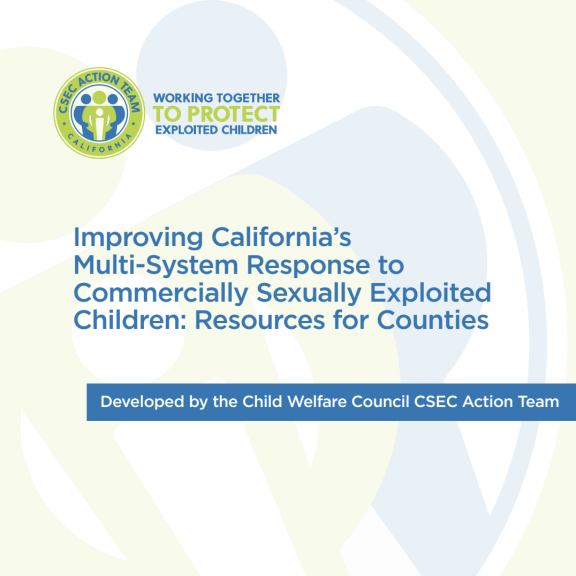Reports
Improving California’s Multi-System Response to Commercially Sexually Exploited Children: Resources for Counties
This toolkit contains the following:
- Executive Summary: this summary defines the scope of the CSEC Problem in California and includes recommendations from Ending the Commercial Sexual Exploitation of Children: A Call for Multi-System Collaboration in California, a 2013 report written by NCYL staff attorney Kate Walker Brown. This report and the advocacy efforts surrounding it were the impetus for creating the CSEC Action Team.
- Memorandum Summarizing the Available Screening Tools to Identify CSEC: this resource was created for the CSEC Action Team by the WestCoast Children’s Clinic. Recognizing the importance of using a systematic screening tool, WestCoast Children’s Clinic completed a survey of available screening and identification tools. These screening tools, often in the form of interviews or indicator checklists, are employed by various child-serving agencies to detect exploitation or heightened risk among children. WestCoast Children’s Clinic compared 15 CSEC screening tools and evaluated them using criteria including: format, length, validation status, intended population, form of trafficking, and domain application (e.g., specific to juvenile justice or universal). The analysis uncovered that not a single tool in the United States has been validated to identify CSEC, which highlighted the need for such a tool. As a result, WestCoast Children's Clinic developed the Commercial Sexual Exploitation-Identification Tool (CSE-IT), which is now being piloted by county agencies and community-based organizations across California. The validation process should be complete by the spring of 2016.
- Model Interagency Protocol Framework: disseminated to counties through an All County Information Notice in April by the California Department of Social Services (CDSS), this resource includes: (1) Background & Purpose, which explains the CSEC Action Team and the stimulus for creating these resources; and the (2) Model Interagency Protocol Framework, which describes the legal requirements of the CSEC Program and offers additional guidance on the infrastructure that should be in place to embark on the reform, including the formation of a steering committee to oversee the county program. This tool helped shape early county dialogue with regard to which agencies should be at the table for the process of developing the protocol.
- CSEC Practice Guidance Toolkit: disseminated to counties in May by CDSS, this resource includes: (1) MOU Template for the CSEC Program, which expands upon the Framework and can be used by counties when developing their interagency protocols; (2) Holistic Needs of CSEC, which serves as a reference point for identifying what needs should be considered in coordinated case planning; and (3) Core Competencies for Serving CSEC, which outlines the skills and knowledge that will help providers identify, serve, and protect children who have been sexually exploited or are vulnerable to exploitation.



